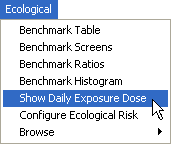
SADA calculates dose (mg/kg BW d) from food ingestion, soil ingestion, dermal contact, and inhalation for terrestrial exposures as well as total dose summed over all pathways selected.
To select a pathway for dose estimation, select a soil contaminant and from the Ecological menu select Show Daily Exposure Dose.

From the following menu, select a receptor and set of parameters from the drop down list. Then, select the pathway(s) for which you want to calculate dose. The parameter sets are SSL, Female, Male, or Juvenile. Choosing SSL will use parameter values from EPA’s Eco-SSL guidance (EPA 2003), which represents data from males and females combined. Choosing Female or Male will restrict the parameter values to those for that gender. SADA does not currently provide parameter values for juveniles, but custom values can be entered via Set Terrestrial Exposure Parameters. Note that SSL parameter values are not available for species not included in the Eco-SSL guidance.

Modeling dose to wildlife receptors requires a number of chemical-specific and species-specific exposure parameters. To view (and/or change) the contaminant-specific or species-specific parameter values used in estimation of dose, close the Daily Exposure Dose window, and from the Ecological menu, click Configure Ecological Risk, and either Set Terrestrial Contaminant Parameters or Set Terrestrial Exposure Parameters.
Model for dose to wildlife receptor from ingestion of contaminated food:
![]()
where FIR BW = Dry food ingestion rate as a function of body weight (kg dry food/kg BW/d)
C plant = Chemical concentration in plant (mg/kg dry weight). Estimated from regression equation, or estimated as C plant = C soil x BAF plant
BAFplant = soil to plant bioaccumulation factor (mg/kg dry plant per mg/kg dry soil)
P plant = Plant ingestion as a percentage of diet (unitless)
C invert = Chemical concentration in invertebrate (mg/kg dry weight). Estimated from regression equation, or estimated as C invert = C soil x BAF invert
BAFinvert = soil to invertebrate bioaccumulation factor (mg/kg dry invertebrate per mg/kg dry soil) P invert = Soil invertebrate ingestion as a percentage of diet (unitless)
Cmamm prey = Chemical concentration in vertebrate, primarily small mammalian, prey (mg/kg dry weight). Estimated from regression equation, estimated as Cmamm prey = Csoil x BAFsoil-to-mamm , or, if transfer factor is diet-to-tissue, as Cmamm prey = Cdiet x BAFdiet-to-mamm .
BAFsoil-to-mamm = soil to mammal bioaccumulation factor (mg/kg dry plant per mg/kg dry soil)
Cdiet = Chemical concentration in diet of mammalian prey (mg/kg dry weight), measured or estimated as Cdiet = (Cplant x Pplant) + (Cinvert x Pinvert) + (Csoil x Psoil) with Cplant, Cinvert, Pplant, Pinvert, and Psoil referring to mammalian prey parameters rather than the focal receptor.
BAFdiet-to-mamm = food to mammal bioaccumulation factor (mg/kg dry mammal per mg/kg dry food)
Pmamm = Proportion of vertebrate prey in the diet (unitless)
AF = Absorbed fraction of chemical from ingested food. Assumed = 1. (unitless)
AUF = Area use factor = ratio of animal’s home range to area of site. Maximum is 1, which assumes animal is on-site 100% of the time. Default is 1. (unitless)
Model for dose to wildlife receptor from ingestion of contaminated soil:
![]()
where FIR BW = Dry food ingestion rate as a function of body weight (kg dry food/kg BW/d)
C soil = Chemical concentration in dry soil (mg/kg)
P soil = Soil ingestion as a percentage of diet (unitless)
AF soil = Absorbed fraction of chemical from soil. Assumed = 1. (unitless)
AUF = Area use factor = ratio of animal’s home range to area of site. Maximum is 1, which assumes animal is on-site 100% of the time. Default is 1. (unitless)
Model for estimation of dose to terrestrial receptors from dermal contact:
![]()
where C soil = Chemical concentration in dry soil (mg/kg)
SA = Receptor’s surface area (cm2/d)
AdF = Adherence Factor, a measure of tendency of soil to adhere to skin. Default set to 1 x 10-6 kg/cm2 (EPA Region IV. 1992. New Interim Region IV Guidance Memorandum from Region IV, Atlanta, Georgia. February 11, 1992) (kg/cm2)
AbF = Absorption Fraction, a measure of the fraction of chemical in contact with skin that is actually absorbed into the body. Default 0.001 for metals and 0.01 for organics (EPA. 1995. Supplemental Guidance to RAGS: Region 4 Bulletins, Human Health Risk Assessment (Interim Guidance). Waste Management Division, Office of Health Assessment, U.S. Environmental Protection Agency, Washington, D.C.). (unitless)
BW = Receptor’s body weight (kg)
Model for estimation of dose to terrestrial receptors from inhalation:
![]()
where IRair = Receptor’s inhalation rate (m3/d)
Cair = Concentration of chemical in air, calculated as Csoil x PEF for nonvolatile chemicals or as Csoil x 1/VF for volatile chemicals (mg/m3)
C soil = Chemical concentration in dry soil (mg/kg)
PEF = Particulate Emissions Factor, estimate of concentration of dust particles in the air (kg/m3)
VF = Volatilization Factor, a chemical-specific soil-to-air volatilization factor (m3/kg)
BW = Receptor’s body weight (kg)
Model for total dose to wildlife receptor from terrestrial exposures:
This model assumes all pathways are checked.
![]()
where Dosereceptor = Dose to wildlife receptor from terrestrial exposures (mg/kg BW/d)
Dosefood = Dose from ingestion contaminated food items (mg/kg BW/d)
Dosesoil = Dose from ingestion of contaminated soil (mg/kg BW/d)
Dosedermal contact = Dose from dermal exposure to chemicals in soil (mg/kg BW/d)
Doseinhalation = Dose from inhalation of airborne chemicals (mg/kg BW/d)